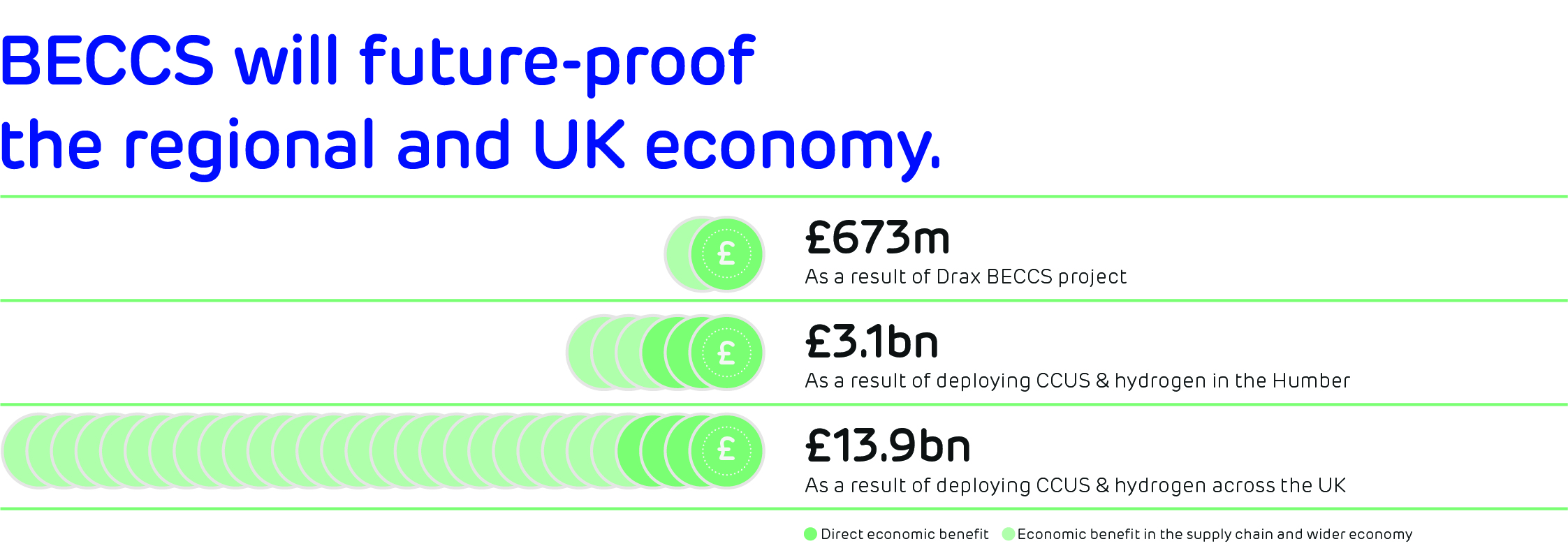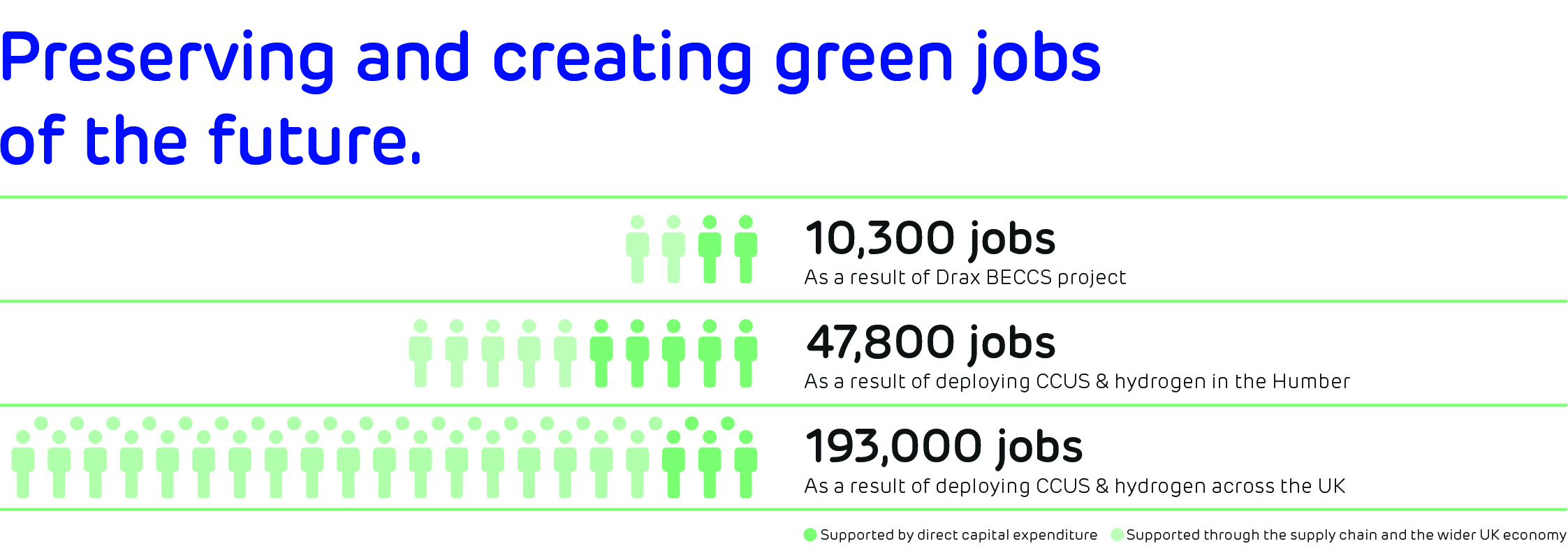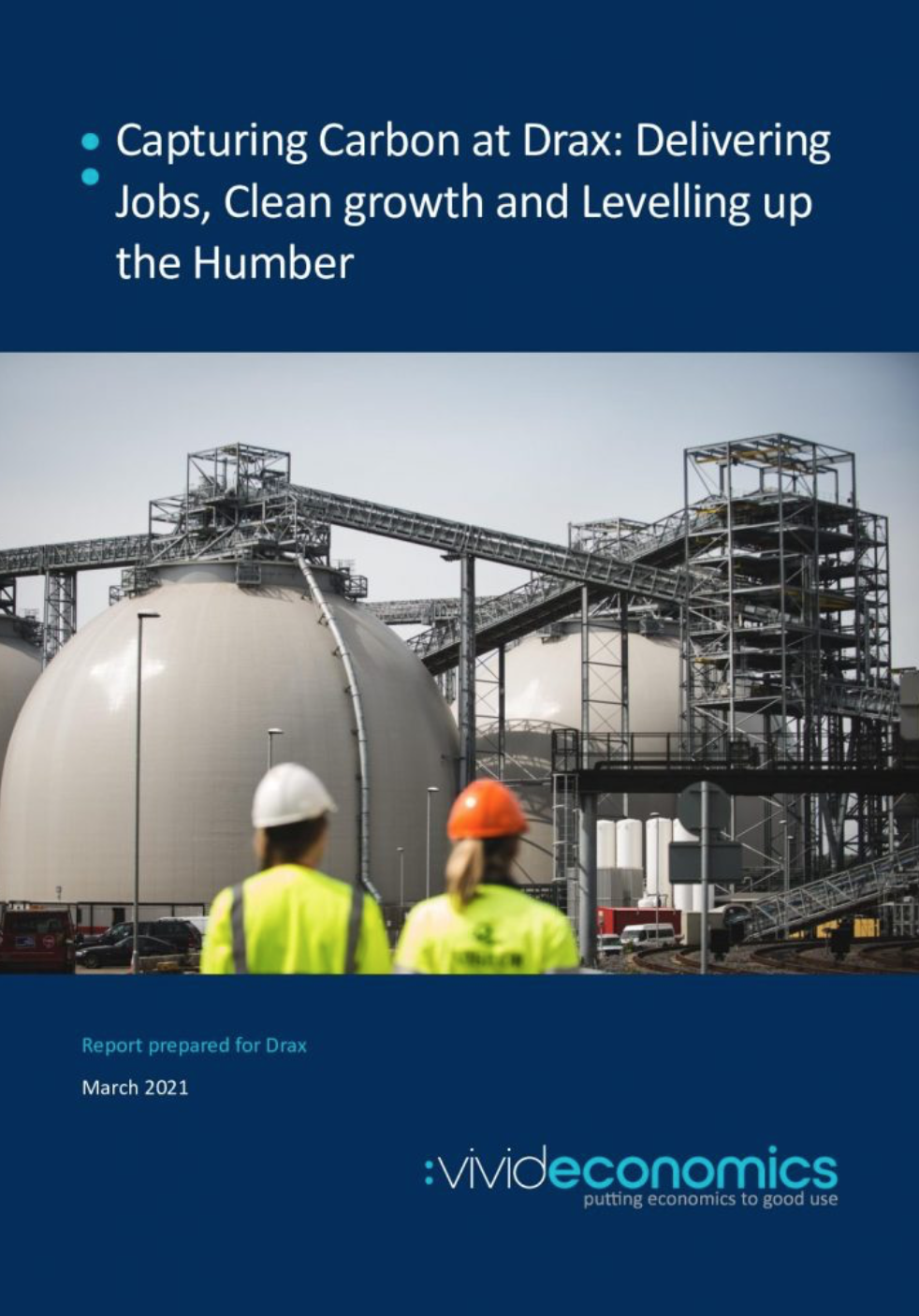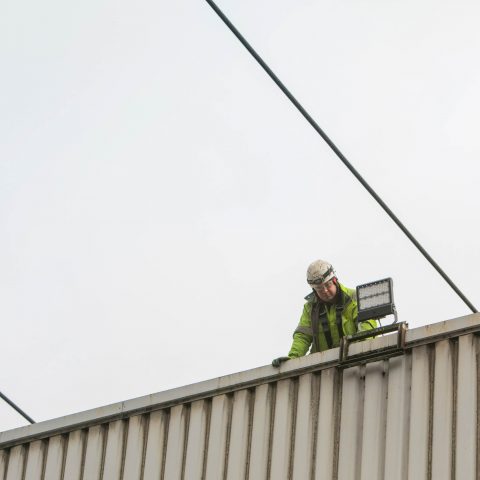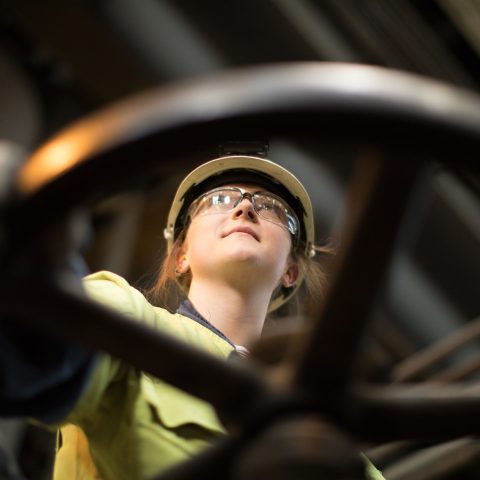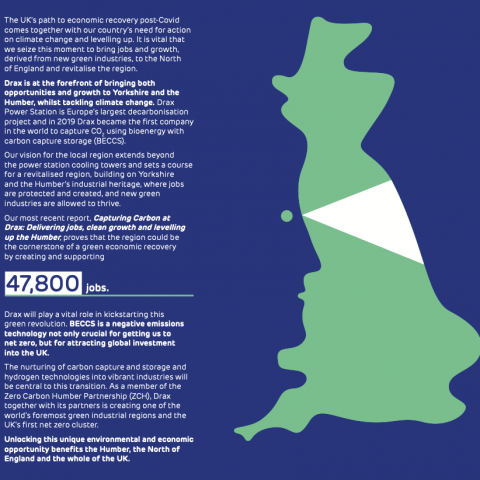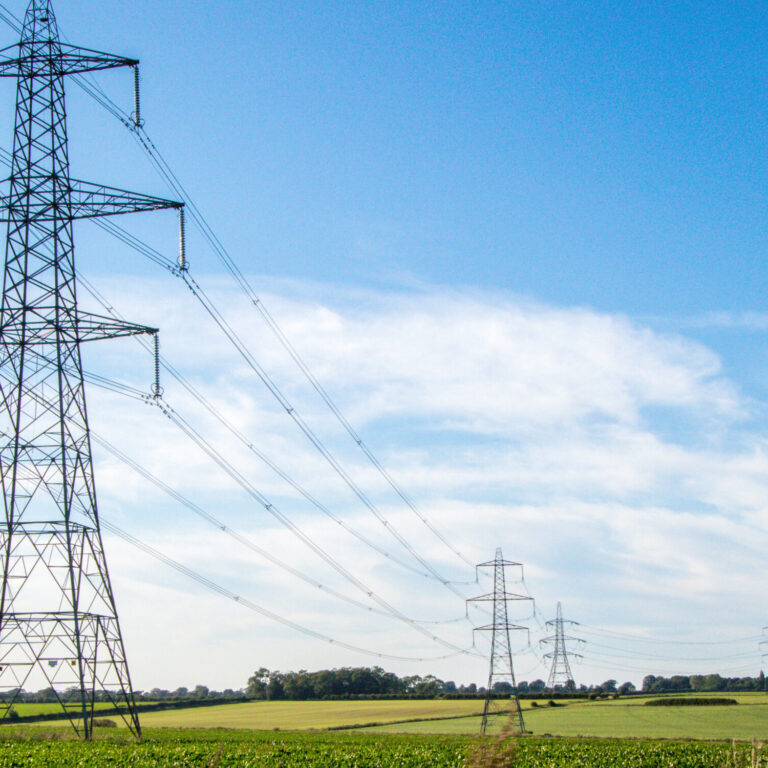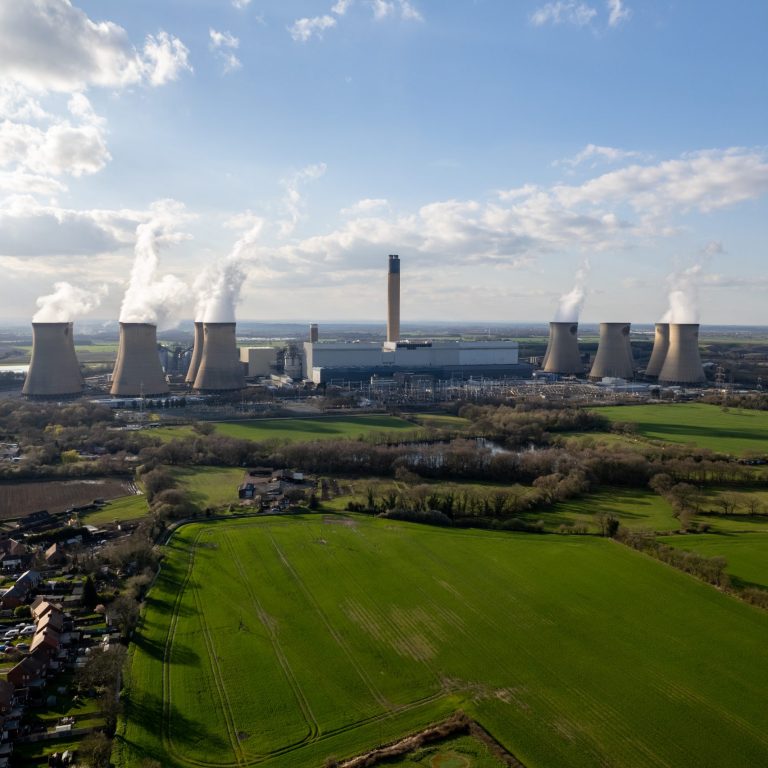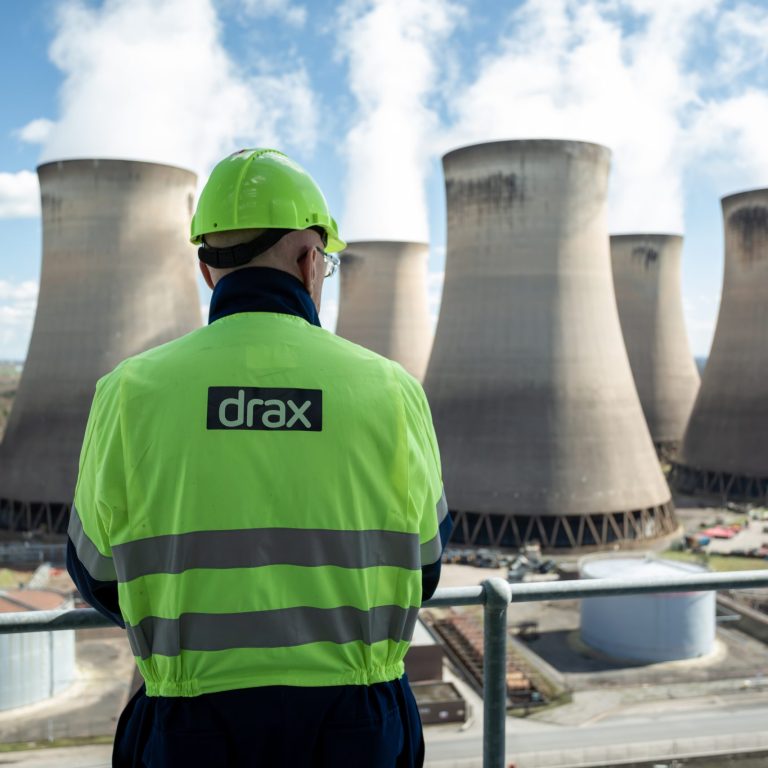Capturing carbon at Drax: Delivering jobs, clean growth and levelling up the Humber
Chapter 1:
Executive Summary
Background
- In November 2019, Drax Group plc (Drax) announced its ambition to become the world’s first carbon negative energy company by 2030.
- To achieve this, it is looking to convert its four existing biomass operations at Drax Power Station to carbon capture and storage (CCS). This technology, also known as BECCS, would generate up to 16 million tonnes of ‘negative emissions’ per year – equivalent to the total industrial emissions from the Humber region today.
- Vivid Economics was commissioned by Drax to quantify the social and economic benefit of deploying BECCS at Drax Power Station. It was also commissioned to provide an estimate for Drax of the socio-economic benefits of deploying CCS and hydrogen technologies at scale across the wider Humber industrial cluster.
- Harnessing hydrogen and CCS technology represents a unique opportunity to build back better as part of the Covid-19 recovery and transform the UK’s most carbon intensive industrial cluster into the world’s first carbon neutral industrial cluster by 2040.
- The Zero Carbon Humber partnership, comprised of 12 leading companies and organisations across the Humber including Drax, have recently submitted a joint public-private sector funded bid worth around £75m to support the deployment of CCS and hydrogen technologies in the region. This bid illustrates the significant potential CCS and hydrogen projects present to safeguarding existing jobs and creating new, highly skilled jobs in the region.
- Vivid Economics’s analysis of the socio-economic benefits of deploying CCS and hydrogen technologies in the Humber seeks to further develop industry and government’s understanding of the economic opportunity in the region. It complements the Hy-Deploy analysis undertaken by Element Energy for Equinor and the forthcoming analysis the Humber LEP and CATCH will undertake as part of their joint Humber Cluster Plan.
Building back better at Drax and the Humber industrial cluster
- As many as 47,800 direct, indirect and induced jobs will be created as a result of deploying CCS and hydrogen technologies in the Humber region. Working in partnership with the UK Government, these new jobs could begin to be realised in as little as four years’ time (2024), peaking at 47,800 jobs in 2027.
- These jobs include up to 25,200 high quality jobs in construction, such as welders, pipe fitters, machine installers and technicians; with a further 24,500 supported across the supply chain and wider economy.
- Developing BECCS at Drax itself would support on average 8,081 direct, indirect and induced jobs per year during construction between 2024 to 2031, peaking at 10,300 jobs in 2027.
- BECCS at Drax would also generate an additional £295 million on average in direct GVA each year during the construction period (2024 to 2031) – and an additional £98 million per year and £130 million per year in indirect and induced GVA Total GVA peaks at £673m in 2027.
- Deploying CCS and hydrogen technologies in the Humber would also deliver a peak of over £3.1 billion per year in direct, indirect and induced GVA in 2027 for the Humber economy.
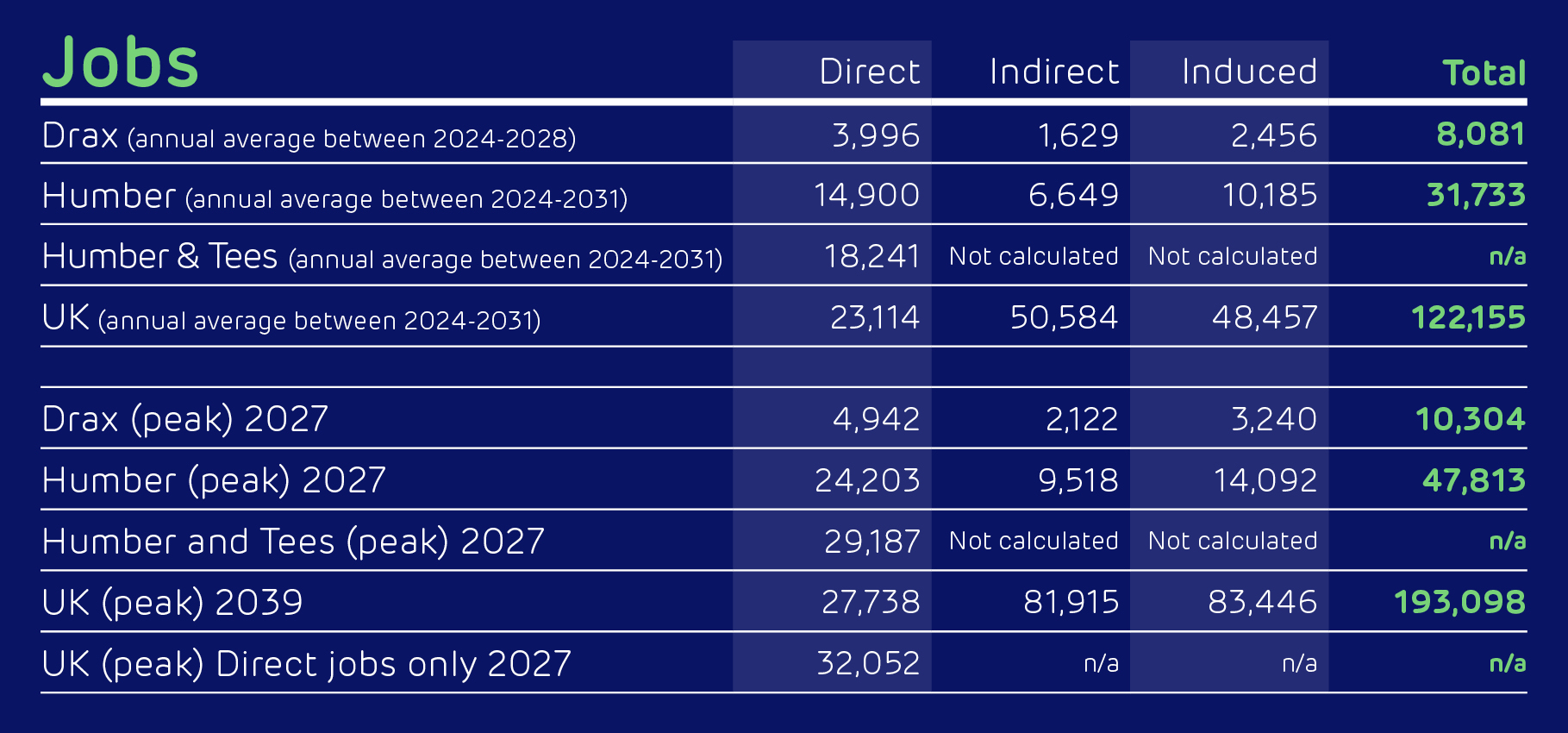
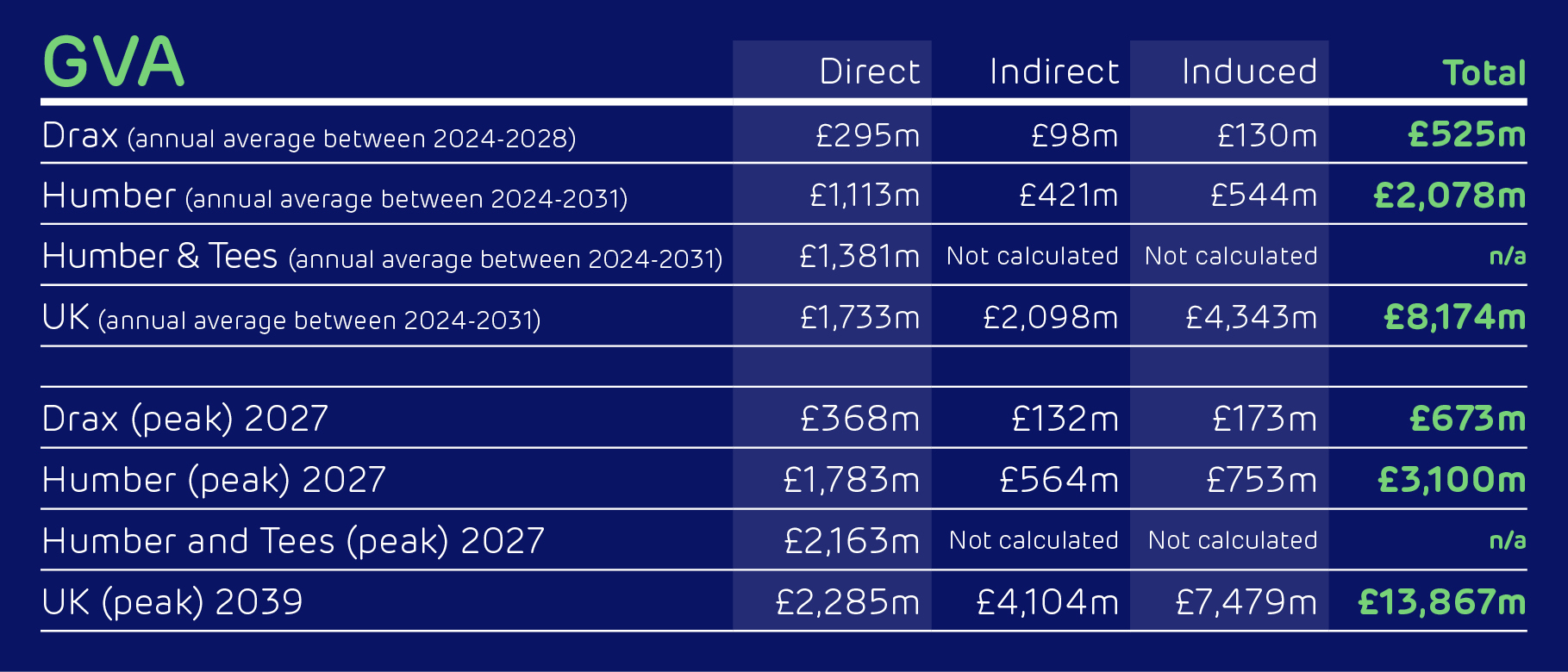
Realising the joint opportunity of Humber and Teesside
- As part of its commission, Vivid Economics also considered the benefits of rolling out CCS and hydrogen technologies in the Humber and Teesside industrial clusters, utilising shared CO2 transport and storage infrastructure in the Southern North Sea.
- Developing the Humber and Teesside industrial clusters in parallel would on average support 18,241 direct jobs per year during the period 2024 to 2031 (peaking at 29,187 in 2027).
Levelling up through CCS and hydrogen
- At its peak, the Humber and wider UK deployment of CCS and hydrogen technologies could support over 193,000 direct, indirect and induced jobs and almost £14 billion in direct, indirect and induced GVA.
- Developing CCS and hydrogen technologies at Drax and across the wider Humber industrial cluster can help reverse a growing skills and investment gap in the region.
- CCS and hydrogen technologies have the opportunity to create high quality jobs in the low carbon economy, during both the construction of projects and their subsequent operation and maintenance. These jobs include welders, pipe fitters and machine installers.
Chapter 2:
Green jobs
Defining jobs
- Direct jobs are jobs supported from direct project expenditure, such as jobs supported when a compressor is purchased for installation on site.
- Indirect jobs are those which are supported from spending in the wider supply chain, such as those supported when the manufacturer of the compressor pays for instrumentation to install on the compressor before it is sent to site for installation.
- Induced jobs are those which are supported from spending in the local economy by employees, such as when the technician commissioning the compressor on site purchases a coffee at the local sandwich shop.
Chapter 3:
Perspectives: Member of Parliament, TUC, Hull Chamber & CBI

Andrew Percy MP
How a decarbonised Humber industrial cluster could help power the UK’s green economic recovery
Comment from Andrew Percy, Conservative MP for Brigg and Goole, October 2020
“The Covid-19 crisis has intensified pressures on businesses and industry in across the region, with employment volatility and economic uncertainty increasingly concerning. The UK Government has made clear that the UK’s economic recovery will be underpinned by keeping businesses in operation, supporting jobs and re-skilling the workforce. We must ensure we are not left behind in this journey to recovery.
“CCUS and hydrogen promises to bring resilience to industries in the region and ensure they are fit for purpose as the UK embarks on greening the economy. It can unlock the opportunity to build the world’s first net zero industrial cluster and decarbonise the north of England. Industry in Yorkshire and the Humber are essential to the UK economy, but are the highest emitters of CO2, so decarbonising industry in the north will be crucial to reaching the UK’s 2050 net zero target, as highlighted by the UK’s Climate Change Committee.
“CCUS and hydrogen can help deliver on this ambition in a way which ensures that the whole region benefits during the transition, through job creation and economic prosperity. A net zero cluster in the region will create a large-scale negative emissions infrastructure in the Humber and Teesside, boosting the local supply chain and supporting jobs. This will place the north of England at the forefront of the global energy revolution, simultaneously establishing an industry that will lead in clean technologies. We can turbo-charge economic growth in the region, attract investment, create skills and thousands of jobs for now and for the future.
“The pandemic has highlighted the need for resilience, which calls for the safeguarding of jobs and addressing the burgeoning skills gap. A decarbonised Humber industrial cluster can seize the opportunity now to create a prosperous economic, social and environmental post-Covid regeneration of the Yorkshire and Humber region which will power the UK’s economic green recovery.”
How CCUS could help transition the region to net zero
Interview with Bill Adams, TUC Regional Secretary for Yorkshire and the Humber region, October 2020
Bill says that CCUS is helpful not just for Drax, but in decarbonising cement and steel works on both sides of the river also. He says that since up to 30 years might be needed to get to net zero, investors may be nervous to invest in a 10-year project without certainty for the next 30 years. The TUC is willing to work with local unions to support this transition, who themselves want to work with government. What local companies want, Bill suggests, is to negotiate a realistic transition such that instead of stranded assets, the region has ‘future-ready’ assets.
CCUS and the broader net zero transition can help play a wider role in achieving the goal of a quality retirement for those who – like the previous generation of miners – now risk being left out of the transition because they’re at a later stage of their career and may choose to not retrain. For apprentices – such as the 250/year who attend Sheffield Advanced Manufacturing Research Centre – training at companies like Drax and Equinor will be absolutely essential, Bill suggests. He points out that it is all about establishing a social partnership between unions, businesses and government to hit net zero, since there are for example, lots of ‘bright young kids who just want to have good jobs and normal lives – companies should give them a chance’.
On the role which government can play, Bill believes low-to-negative interest rates mean that now is the time to invest to minimise stranded asset risk. In particular, he believes that the export potential of the technology is large, and the UK could play a leading role in helping the likes of India and China decarbonise. The UK Government’s promises to invest in the North can be combined with the hunger for yield at pension funds to invest in CCUS now.
The TUC sees great potential when it looks at its friends in Germany. What’s happening here with the transition away from coal? He paints a wonderful picture, providing the example of Eastern German coal mine (Kochbuss) – turning the coal pit into a man-made lake, creating high-tech industrial jobs in the region, changing the curriculum. He contrasts that with a potentially dystopian vision for the Humber unless CCUS and Hydrogen help to transition away from fossil fuels. He concludes the interview by powerfully making the case that CCUS is about creating ‘breathing space’ so the region does not go through a decline.
Export opportunities for CCUS and net zero
Interview with Pauline Wade, Director of international trade at the Hull and Humber Chamber of Commerce Hull Chamber of Commerce, October 2020.
Pauline says that the Port of Hull is a key driver of investment in the local economy. Energy, chemicals, materials – everything is dependent on the port and as the UK accelerates deployment of renewables to meet net zero, the port will become more important than ever.
She suggests – from her experience leading over 60 UKTI sponsored Trade Missions and exhibitions – that investment in the region can be improved through better East-West connectivity (primarily road and rail improvements) and better connectivity with Europe. Government has a role to play here.
Hull has a proud history of being a place where a range of nationalities from Europe and beyond have settled because of the high quality of life, she says. The Siemens factory in Hull has been a really positive boon for the local economy and investment in a big R&D hub by Reckitt Benckiser has shown that the region is able to bring in the best and brightest scientists and engineers.
The Hull Chamber of Commerce believes that knowledge and expertise in the region will grow with net zero. Exporting the region’s scientific and technical skills, machinery, equipment and services to Europe and the rest of the world presents an excellent opportunity to become a global leader in delivering net zero.
Opportunities for upskilling
Interview with Beckie Hart, Regional Director, Yorkshire and the Humber, CBI , October 2020.
The CBI connects and supports businesses in the region. Beckie identifies a number of key strengths in different parts of the region, ranging from advanced manufacturing in South Yorkshire to technology, retail and finance in Leeds. The region is not only economically diverse but also has a bigger GDP than the whole of Scotland.
Beckie also sees some of the challenges in the region: the prevalence of ‘traditional’ industries such as fossil-based manufacturing, Universities which are attended primarily by those born and bred nearby, high levels of youth unemployment, educational outcomes lower than the regional and national average, ‘lower aspirations’ than elsewhere, a regional culture which causes people to stay in more than in other regions, causing businesses to reconsider investments.
Beckie suggests that her experience on the ground with local businesses has found that the skills gap operates at both ends of the spectrum: labour-intensive industries struggling to find labour where automation is expensive, as well as big engineering and chemicals companies struggling to find and retain high quality managerial staff.
At the same time, there are tremendous opportunities in the region: some quite big companies are already based there and the long-term vision of decarbonising the region is a ‘really exciting proposition’. Beckie points out that the region has gone from decline after the end of the commercial fishing industry, to growth through industry. Now is the time to go from being ‘the dirty corner’ to ‘the clean corner’ to avoid decline as the push for net zero accelerates. A lot of regional businesses recognise that they have high emissions but ‘want to be part of the solution’.
She points out that the Chancellor’s Kickstarter scheme won’t be enough to fill the skills gap at the lower end of the skills gap spectrum, as some of these are quite young. What is needed is for the Government to urgently release its Energy White Paper and for a strategy around how to get school-age children on paths to contributing to the net zero transition. Could remote-working technology be used to get the likes of Drax and other businesses in the Humber into classrooms to do this she ponders?
Chapter 4:
Economic benefit
